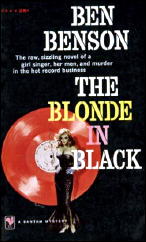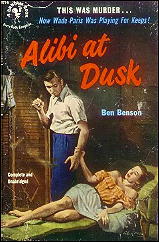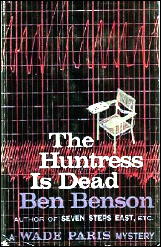Sat 26 Jun 2010
BEN BENSON – The Blonde in Black. Bantam #1974, paperback reprint; 1st printing, July 1959. Hardcover: M. S. Mill; first edition, February 1958.

When the subject of police procedurals comes up, and which authors were among the first, Lawrence Treat and his novel V for Victim (1945) is often cited as the first of those in the modern era.
There were, of course, any number of candidates in the 1930s and even before. The idea of police solving crimes is a natural, after all; private eyes and purely amateur sleuths can’t have all the fun.
Ben Benson, whose books in softcover I’ve owned for many years (there were 19 of them and this is, alas, only the second one I’ve read) has somehow become neglected as one of the early authors in the field.
His first book, Alibi at Dusk, came along in 1951, for example, and there were not many other authors who might fit into the category between Treat’s books and his. As a minor quibble, if you were to look closely at The Blonde in Black, you might say that it does not really fit the category — if the category consists of a police department at work upon several unrelated crimes at the same time.
But if a police procedural can also consist of several members of a police department working as a team, following professional guidelines and conducting a case coolly and intelligently, then The Blonde in Black does indeed qualify, and presumably so do all of Benson’s other books.

The blonde in question is Junie Jacques, whose image as a sexy singer has been built as a gigantic case of fraud by her record company. She’s in reality a home town girl from Massachusetts who needed the money and agreed mostly against her will to go along with the image the public knows her by.
And when she tells her record company executive that she’s quitting to get married, to the nephew of the governor, he’s fit to be tied. He’s also very quickly dead, with the D.A.’s office ready to arrest Junie for his death, which she claims to have been only a shooting accident.
Captain Wade Paris of the Massachusetts State Police is not so sure of Junie’s guilt, and he continues his investigation anyway, regardless of what the ambitious fellow from the D.A.’s office might think.
In one sense, this is an impossible crime, since Junie’s warning shot against what she thought was an intruder was in the air and toward the figure coming toward her, and as it turns out, the man was shot in the back. But the shot came from her gun, and only one shot was fired.
A fact which may sound insurmountable, but it’s easily enough solved. (It didn’t take me much time to figure it out, in other words.) Most of the book is taken up, in documentary fashion, with the ins and outs of the music business as it was in the 50s, in what it took to create an image the public would go for; payola to grease the palms of important disk jockey’s; the expectation that girl singers would do whatever it took to get ahead; and so on.

Benson’s a bit stodgy in the details here, nor does he see a lot to rock-and-roll singing beside the well-planned gyrations on stage, but his policemen, while largely faceless, do know their business. And on the other hand, while the case is a slight one, the other characters involved are real enough to have convinced me.
Ben Benson died young, in 1959, at the age of only 44, and I don’t know any details. His 19 books were written in a span of less than ten years, the last, The Huntress Is Dead (1960), being published after his death, and was never published in softcover.
Wade Paris was in ten of his novels; a Massachusetts state trooper named Ralph Lindsey was in another seven. There do not appear to have been any crossovers, but I’d love to be corrected about this. The other two books Ben Benson wrote consisted of one standalone novel and a collection of two novelettes. (Thanks to Roger Ljung, whose comment made an essential correction to this statement.)
[UPDATE] Later the same day. I have discovered one source online that says this about Benson:
“[He] was born in Boston and seriously wounded during Army service in WW2. He began writing as therapy…” A complete list of Benson’s novels can also be found on this site.
[UPDATE #2] 07-01-10. I recently received the following email from Victor Berch, with a cc sent to Al Hubin. The updated information about Benson will appear in the next installment of the online Addenda to the Revised Crime Fiction IV.
Hi Steve:
I became interested in your review of Ben[jamin] Benson’s books and since he was a Boston boy, I decided to check on his vital statistics. I know Contemporary Authors and other sources assign a 1915 birth date to him. However, according to the Massachusetts Vital Records, 1911-1915, there was no Benjamin Benson born in 1915.
What little data that is presented in Contemporary Authors reveals that Benson had enlisted in the US Army in 1943. So, I decided to check out any statistics that might appear in his Army record. Sure enough, his record was available.
It stated that he had enlisted in Boston on Sept. 24, 1943 as a private for the duration of the war (his Army serial number was 31422170, should anyone care to explore his record further). His year of birth was given as 1913, had two years of college education and his civilian occupation was given as a salesman.
Armed with that 1913 birth date, I went back to the Massachusetts Vital Records, 1911-1915. And his record was available. The data revealed that Benjamin Benson II had been born in Boston June 14, 1913, the son of Hyman D., a printer, and Rivka [Rebecca] (Charmonsky) Benson, both immigrants from Russia.
Whatever the family name originally was would have to be obtained from his father’s naturalization papers. His family had only immigrated to the US in 1912.
Best,
Victor
June 26th, 2010 at 4:54 pm
The one Benson that I have read (The Girl in the Cage, a Ralph Lindsey novel) was quite good. Benson is one several authors I have always meant to get back to.
My information about Benson comes from an entry by Marvin Lachman in the St. James Guide to Crime & Mystery Writers (1996). He attended Suffolk University Law School, and was awarded a Purple Heart and two battle stars while in the army; his war wounds resulted in his being hospitalized for three years. He worked as a tea salesman before becoming a full-time writer in 1949. He was also a member of the Board of Directors of MWA.
Most interesting to me is a book he published before going into the army: Hoboes of America: Sensational Life Story and Epic of Life on the Road by Hobo Benson (New York: Hobo News, 1942). Now that is one book I’d love to read!
June 26th, 2010 at 8:14 pm
I have about half of Benson’s books and always on the hunt for the rest. He was one of the better suspense writers in the field and both Wade Paris and Ralph Lindsey were attractive and believable protagonists. It’s a shame he’s forgotten a bit today. He’s one of several good writers from that era who are too little read today.
For an early American police procedural check out THE LAST DOORBELL by Frank Gruber writing as John K. Vedder. It still holds up pretty well.
June 28th, 2010 at 2:02 pm
I’ve liked everything I’ve read by him – I should say that means some four or five Lindsey novels.
June 30th, 2011 at 8:00 am
“Wade Paris was in ten of his novels; a Massachusetts state trooper named Ralph Lindsey was in another eight. There do not appear to have been any crossovers, but I’d love to be corrected about this. The other book Ben Benson wrote consisted of two (non-series?) novelettes.”
Hi! I recently read The Black Mirror by Ben Benson. Neither Lindsey nor Paris appeared. And it doesn’t consist of two novelettes either. The Black Mirror is a novel about the small, corrupted and tourist-friendly town Belleview and the protagonist is called Peter Bradford.
June 30th, 2011 at 10:40 am
Thanks, Roger. I made a big error in the earlier version of this blog post, which I’ve just now corrected. Lindsey was in only seven novels, leaving THE BLACK MIRROR as a standalone, while THE FRIGHTENED LADIES is the book that’s a collection of two novelettes, “Lady in Hiding” and “Lady with a Past.” (I do not know whether the stories were originals, but I suspect they are.)
November 10th, 2011 at 10:40 pm
By the way – if the dates at the begining of the post are accurate – the Spanish translation was published in paperback before the English paperback hit the streets… it came out in Argentina in December 1958.
May 5th, 2013 at 6:54 am
A police procedural is nothing more or less than a piece of crime fiction that depicts the profession of law enforcement with technical accuracy (or at least with the appearance of technical accuracy). By that standard, Benson’s novels more than meet the criteria. He was also almost alone in depicting the work of a state police force.
How may cases an agency may be working on is not the defining element. If working on a single case eliminated a work from consideration, most episodes of DRAGNET would not make the cut, and any defintion that eliminated DRAGNET would, I think we can all agree, be ludicrous.
Ben Benson was, indeed, a pioneer in the police procedural (a term coined by Anthony Boucher in 1956), and his carefully researched novels about the MSP deserve to be better remembered.
December 29th, 2017 at 11:25 am
I am ben benson’s daughter and can clear up some questions. He did NOT write the Hobo book. There was a hobo who had the same name.
December 29th, 2017 at 3:52 pm
Nancy
Thanks for the correction on that. Much appreciated!
I also hope you were pleased to see what well remembered your father is, at least by a strong vocal handful of us!
— Steve
April 4th, 2019 at 9:01 am
Hello
Ben Benson also has at least one big fan in Belgium, who’s also trying to trace and buy his complete output. I’ve also dedicated an article to him, in Dutch unfortunately, but with Google Translate, it still might be possible to understand largely what it says. It can be found here: http://www.retroscoop.com/amusement.php?artikel=67
Mrs. Benson-Berry, I’d love to get in touch with you. There is so little information about your father available, and apparantly, some of these bits seem to be incorrect. It would be wonderful if you could add some extra facts that only a family member could add for us, Benson-buffs. What could be added is that at least one of BB’s books was used as inspiration for a movie, and that he contributed to the book “The Mystery writer’s handbook” (Edit. by Herbert Brean)
Keep up the good work !
Benoit Vanhees Antwerp Belgium
http://www.retroscoop.com